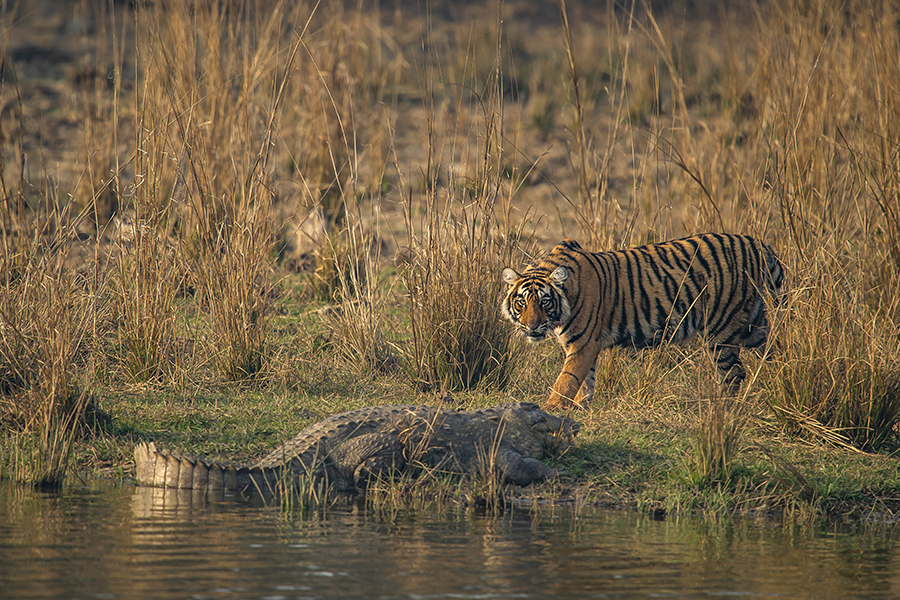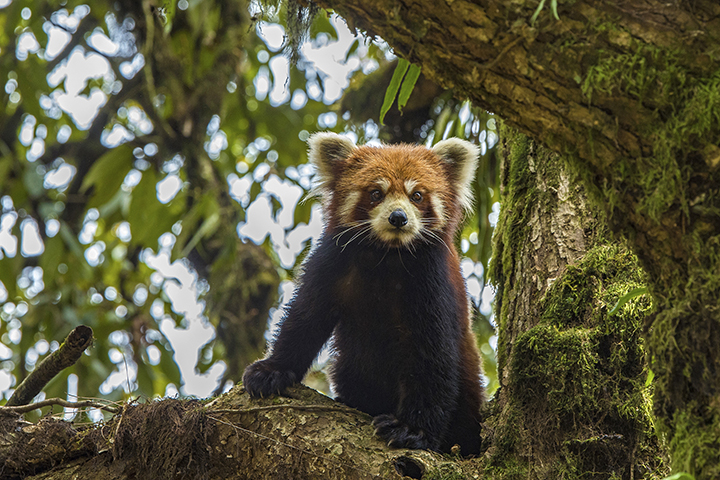 April 10, 2020
April 10, 2020
Tiger vs Croc
One of my favourite places in the country is Ranthambhore National Park. Over the past 6-7 years, I’ve been there over a dozen times and now it has pretty much become a second home. I’ve been watching and photographing different tiger families raise their cubs who in turn bare off-springs and the lifecycle goes on. Interestingly a tigress when she was about a year old confronted a Crocodile and 5 years later, her cubs too, took on another crocodile.
Before I can start narrating about the confrontation of tigers and crocodiles, it would be better if readers were familiar with tiger names and the outline of the family tree. All tigers in Ranthambhore that are above 2 years old and captured on a camera trap/trail camera are numbered for identification. Younger tigers aren’t numbered as their chances of survival and attaining adulthood and relatively low.
The famous Tigress who was featured in a number of documentaries including BBC’s Natural World series and fondly referred to as ‘The Lady of the Lakes’ by residents and frequent visitors to Ranthambhore was the late Machli – T16 (1996-18 Aug 2016). I had the privilege of seeing her just once during her last days. She was weak, pushed out of her territory and was unable to hunt at that point. Rewind back a decade and she was a show stopper in the park. Tourists from around the globe flocked to see her.
I think it was in 2003, there was a severe drought in Ranthambhore and Machli single handedly took on a big crocodile probably about 12-14 feet long and the mugger succumbed to the attack. Macchli lost two canine teeth during the hunt. Yet she survived for 13 years after the incident and raised cubs to adulthood. The influx of poachers caused the tiger population to plummet to below 20 Tigers. She managed to survive the poaching turmoil and her lineage contributed greatly to repopulate Ranthambhore. She was the unproclaimed ‘Tiger Queen’ who reigned over the beautiful lakes of the park.

In Machli’s last litter, she gave birth to 3 females, Sundari – T17, Bhagani – T18 and Krishna – T19. Sundari was missing since around 2012-13 and has not been seen since then. Her young cubs were raised to adulthood by their father and Sundari’s mate Zalim – T25. It was the first time that such a rare behaviour of a male tiger raising cubs was recorded and also made into a film – Tiger’s Revenge. Do watch it when you find time. It streams on Youtube. I haven’t seen Sundari, but I have seen her cubs as well as Zalim. Zalim was recently found dead. The reason for his demise could probably be old age.
Bhagani was relocated to Sariska, the park which lost all its tigers to poaching. Today, Bhagani thrives in her new home. Sundari before she went missing took over the lakes from her mother and eventually afterwards, Krishna – T19 claimed her mother’s territory around the lakes. Krishna’s second litter consisted of Arrowhead – T84, Lightening (both females), Pac man (male) and a fourth cub that didn’t survive too long. The above photo is of Krishna and these three cubs from February 2015 when they were about a year old.

One morning in February 2015, Krishna and her cubs were around the lakes. It was around 9:50 and we had just 10 minutes left before we could exit. My driver was wanting to leave, but my guide said, lets wait for just 2 more minutes. The gate of course was just 5 minutes away. After all but 2 vehicles had left, a crocodile swam across along the shore and one of Krishna’s cubs which I presume is Arrowhead came out of the bushes snarling at the crocodile.

Behind the cub came Krishna striding towards the swimming crocodile and she stopped and sat down once the croc went underwater. It was time for us to leave back to the gate and I put my camera down. Suddenly, the croc surfaced again and she got up and charged at it. It was indeed a great moment missed but getting out of the park on time was more of a priority at that point. I thought that the morning was a once-in-a-lifetime chance and seeing this interaction again may not be possible.
The cubs grew up and Arrowhead overthrew her mother Krishna from her territory and took over the Lakes. Pac man succumbed to injuries in a fight with another tiger and Lightening was relocated to Sariska. Arrowhead had her first litter in early 2018 but lost the cub(s). Once again in 2018 end or early 2019, she had 2 female cubs and they were named Riddhi and Siddhi, yet to be numbered. In February 2020, I was back again in Ranthambhore hoping to see the cubs for the first time. I missed seeing them in my previous trips in 2019. Luck was on my side this time and on the first day,

It was Arrowhead. Resting by a waterbody and the cubs were no where to be seen. She lay down for close to an hour and I patiently waited knowing for sure that she would get up. At a distance, there was a faint alarm call of a deer and guides around were speculating in which direction it came from and probably if it were the cubs. Arrowhead got up, all alert and a cub came out of the bushes from the opposite direction of the call. It was the other cub. So both were in the same area moving towards the mother. There was a squabble between one cub and Arrowhead and they moved into the hunting palace ruins.

We waited again, another half an hour passed. Across the lake, there was some movement which my guide noticed and it was the Cubs on the shore. Drove up to the other side and the two cubs were sitting by the Lake. It was hazy and the visibility was okay. Looking through the lens, I see a crocodile sun basking and the cubs looking at it.

Making a bold move, one of the cubs approached closer. It stared first, then snarled and then sat down. What was happening there wasn’t quite unusual because this cub’s mom (Arrowhead), grandmom (Krishna) and great grandmom (Machili) have all at some point of time confronted Crocodiles and there’s also been a history of its ancestors taking on and killing one. The cub sat near the croc for a while, before eventually loosing interest and walking away. Having spent a considerable amount of time in Ranthambhore, I have learnt a lot about the park’s tigers from guides and drivers, film makers and many others and it is quite interesting to be able to document such uncommon behaviour of these Big Cats. May their tribe flourish!
Author: Gaurav Ramnarayanan




